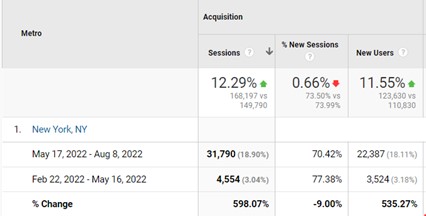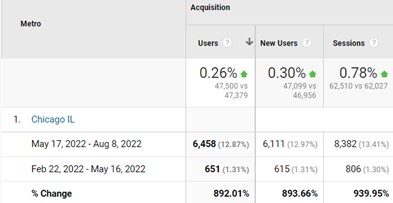Are you seeing NY, LA, Chicago as top markets in your Google Analytics?
If you’re like most of our partners, you’ve seen a few odd markets jump to the top of your Google Analytics.
We’ve seen DMAs (Designated Market Area) like Chicago, New York, and even LA skyrocket to the top. In some cases, one or more of these may be a target market for you, but with most tourism organizations in the southeast, it is not. Even if it is a target market for you, it is not usually the top market for site traffic.


We’ll walk you through what changed with this tracking, what to expect moving forward, and how to know your digital campaigns are still effective, even if you can’t see the right markets in analytics
It’s not breaking news that privacy regulations are ever-changing. The EU and many other countries have already adopted new laws that have changed our websites and the way we monitor website behavior. I.E. GDPR from 2019, where we all had to change our websites for users to opt-in to cookie tracking. With the continuing concerns around data privacy, Apple and other major tech continue to evolve what third parties can collect from our devices.
With that comes things like ‘the end of cookies,’ and GA4, GA FLOC (now sunsetting the idea), and of course smart phone updates like Apple’s multiple updates this year, just to name a few. The newest Apple update specifically for Safari in May of this year, appears to have a large effect on the way Google Analytics tracks device locations.
Our Director of Digital and Audience Targeting Dave Herrold says, ‘Safari’s 15.5 update automatically opts in users to IP (Internet Protocol) obscuring that limits the accuracy to countries & time zones.’ See screenshot for what it looks like on your iPhone. This is greatly affecting website traffic because over 47% of people in the U.S (United States) have an iPhone and use Safari as their main browser on it.

If you have the most recent iPhone update, you can check out your own phone for this new update:
Go to settings > cellular > cellular data options to view if IP address tracking is limited (green) or not (gray).
In short, this means that all updated iPhones are not sharing proper location data from IP addresses. We cannot count on users to always connect to Wi-Fi to overcome this, and we can’t just exclude iPhones. However, there are ways to ensure your marketing is still reaching your ideal audience.
So, now that you know what is happening and a little more about why, let’s talk about what you can do about it so that you are sharing the most accurate information with your stakeholders, as well as know your campaigns are still targeting your ideal markets.
First and foremost—explain the shifts in data collection to your stakeholders starting now. The sooner you start these conversations with them, the better off you will be as things continue to change.
As far as your marketing campaigns—we always recommend not to make any major shifts from one set of data. We know Google Analytics is probably a primary data set for user behavior, but don’t forget to look at campaign delivery by market.
If you do feel like changes need to be made, here are a few options you should have with your marketing partner.
-
If target markets are more important than target personas, consider geofencing campaigns. Most geofencing platforms target based on Device ID and not IP address. It has always been much more accurate in finding users’ actual location than IP targeting.
- Consider custom network targeting regional websites—news websites in your target markets or other local publications.
- Use your own first party data from your Newsletter sign ups and Visitor Guides form fills for targeting and lookalike targeting. This is something you should be doing even if this update had not happened.
- Contextual targeting is a great option and increasingly more important as we approach a future focused on user privacy.
- You can also adjust your campaigns to target at state levels with audience targeting—looking for the right behaviors instead of the exact location.
Most importantly, do not worry and do not stress. Your digital marketing partner will be your best resource navigating these ever-changing waters. Like us, they will be watching every aspect of your campaign and monitoring it regularly for shifts.
User privacy continues to be at the forefront of digital advertising conversations, so this will continue to be a topic across the industry. We will keep our partners and future partners up to date on these changes as they continue.
As we like to say, the only constant is change.
Advance Travel and Tourism is at the forefront of digital marketing for tourism organizations. Reach out any time to chat about strategy, data, or marketing. It is not just our job; it is our passion–we are here to help your organization grow.
Sources:
https://support.apple.com/en-us/HT212614
https://www.analytics-ninja.com/blog/2022/06/apples-safari-15-5-impact-on-geolocation-analytics.html
https://www.searchenginejournal.com/google-sunsetting-universal-analytics-in-2023/442168/
https://gs.statcounter.com/browser-market-share/mobile/north-america
Learn more about how we can help you adapt to the evolving marketing landscape and ramp up your efforts.
Share This Story, Choose Your Platform!
July 26, 2024

The Cookie Rollercoaster Continues
Have you ever been on a rollercoaster that stops and you think the ride is over, but then you start going in reverse? That’s sort of what’s happening with online cookies. In 2020, Google announced their plan to phase out 3rd party cookies (the small pieces of data that allow marketers to serve personalized ads across websites). [...]
June 25, 2024

Strong Domestic Summer & Fall Travel Outlook for 2024
When the data speaks loud and clear, no crystal ball is needed to predict short term travel trends. All indicators point to a busy summer and fall 2024, as any concerns about traffic jams, air travel headaches, or overcrowding doesn’t seem to be detering Americans from enjoying their vacations. […]
WE BRING THE TRAVELER TO YOU.
CONTACT US TODAY TO DISCUSS HOW WE CAN HELP REVAMP YOUR TOURISM MARKETING STRATEGY.
"*" indicates required fields


